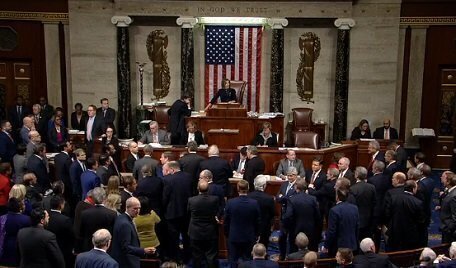The House of Representatives adopted two articles of impeachment against President Donald Trump on Wednesday evening, setting in motion a Senate trial to consider the President’s removal from office.
 The Judiciary Committee recommended both articles by a 23-17 vote on December 13, 2019. After the ensuing debate on the House floor, on December 18, 2019, the full House voted 230-197 to approve the first article of impeachment (with one member voting as Present), setting the stage for a trial in the Senate under Article I, Section 3. The second article was approved 229-198, with one vote as Present.
The Judiciary Committee recommended both articles by a 23-17 vote on December 13, 2019. After the ensuing debate on the House floor, on December 18, 2019, the full House voted 230-197 to approve the first article of impeachment (with one member voting as Present), setting the stage for a trial in the Senate under Article I, Section 3. The second article was approved 229-198, with one vote as Present.
On Tuesday, December 10, 2019, the House Judiciary Committee had introduced a resolution accusing President Trump of committing “high Crime and Misdemeanors,” the standard for impeachment and removal set by Article II, Section 4 of the Constitution. The resolution included two articles of impeachment, one charging that President Trump “abused the powers of the Presidency” by soliciting the interference of the government of Ukraine in the upcoming presidential election and one charging that he obstructed Congress by refusing to cooperate with the House's impeachment inquiry. Both articles stated that the President was a “threat to national security and the Constitution” and must be removed from office—and disqualified from any future office.
After Wednesday’s voting concludes, the House will appoint the “impeachment managers,” typically members of the House, who will prosecute the case in the Senate. Once impeachment managers are chosen, the House will pass and transmit to the Senate a separate resolution formally stating the impeachment charges and the names of the trial managers. The Senate then notifies the House impeachment managers of the starting date of Senate proceedings.
Under Article I, Section 3 of the Constitution, the Senate has the sole power to conduct impeachment trials. As the defendant in this case is the President, the Chief Justice of the United States, John Roberts, will preside over the trial. Standing rules first adopted for President Andrew Johnson’s impeachment trial in 1868 (and updated several times since then) will be used to conduct the trial.
On the proceeding’s first day, the House managers appear in the Senate and formally present the impeachment articles to be tried. The Senate will issue a writ of summons asking the President or his counsel to appear before it and will also set a trial date. The Senate then forms itself as a court of impeachment, with Senators taking a special oath to “do impartial justice.”
The trial will proceed as the House managers and defense counsel argue their cases, and witnesses are called to testify. The Chief Justice will rule on questions about evidence and procedure, subject to being overruled by a majority vote of the whole Senate.
After testimony and arguments have concluded, the Senate will meet in a closed session to vote on the charges. Per Article I, Section 3, two-thirds of the Senators present must vote to convict the President on an article of impeachment.
If the President is convicted on any article, the Chief Justice will announce a judgment of conviction and removal.
Resources from the Interactive Constitution
Neil J. Kinkopf and Keith E. Whittington explain how the Impeachment Clause was included in the Constitution to create another check against abuses by government officials and to give Congress the ability to remove from power an unfit officer who might otherwise be doing damage to the public good.
Balancing independence and accountability in impeachable offenses
Keith E. Whittington says the impeachment power exists at the far margins of American constitutionalism. The Founders sought to create three branches of government, each independent of the others and enmeshed in a system of checks and balances. But the desire for independence had to be balanced against a concern with accountability.
The scope of the impeachment power: what are “high crimes and misdemeanors”?
What sort of conduct is so harmful that Congress is justified in impeaching and removing an officer who commits it? Neil J. Kinkopf explains that the Constitution’s answer is “treason, bribery, or other high crimes and misdemeanors.” Treason and bribery are clear enough, but the concluding phrase “other high crimes and misdemeanors” is anything but clear.
In the Constitution
The House's Impeachment Powers
The Senate's Impeachment Trial Role
The Rules for Impeachment Proceedings
We The People Podcasts
Should President Trump Be Impeached?
What Would Madison Think of the Presidency Today?
What Does the Constitution Say About Impeachment?
Town Hall Videos
“High Crimes and Misdemeanors”: What the Constitution Says About Impeachment







